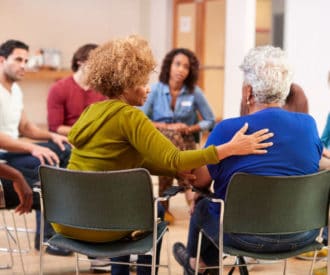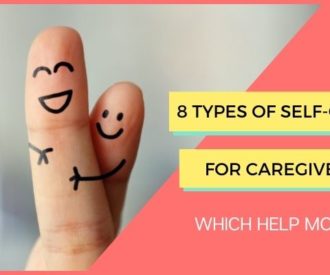
Every time Jacque Pearson tried to devise a plan to move her 81-year-old dad, who has Alzheimer’s, from his home in Boise, Idaho, to hers in Denver, she felt stuck. Then, two weeks ago, she had a breakthrough.
It happened at an AARP-sponsored session in which Pearson created a “CareMap” – a hand-drawn picture showing all the people she cares for as well as the people surrounding those individuals and her own sources of support.
On one side of the paper, Pearson sketched out her father’s situation. There were three friends from Alcoholics Anonymous and his longtime doctor – the people he relies on most. There were three sisters and two sons in Arizona, not very involved. And there she was, the primary caregiver, far, far away.
How could a quick sketch of stick figures (representing the people in her father’s life), triangles (representing his medical providers), arrows (representing relationships between people) and box-like houses (where she and her father live) have this kind of impact?
CareMaps are an intriguing new tool created by the Atlas of Caregiving, an ambitious project that hopes to gather comprehensive data about family caregivers. The project’s pilot study examined 14 families in the San Francisco Bay Area who wore miniature cameras and sensors, kept a log of their activities and participated in extensive in-person interviews.
One of the goals was to understand what Rajiv Mehta, the project’s founder, calls the “ecosystem of family caregiving, the relationships that surround caregivers and that shape their experiences.”
One family caregiver might be at odds with her siblings but have a close group of friends she can turn to for emotional support as she cares for a disabled husband, for example. Another might be divorced but have a son living at home who can help with practical responsibilities as he cares for his mother with Parkinson’s disease, who moved in a year ago. Yet another couple in their 60s, both struggling with serious illness, may rely primarily on their three children, all living nearby, but have few friends.
How could these webs of relationships – people who are caring for each other and who are cared for, in turn, by others – be portrayed? Interviewers started drawing them quickly as family members were speaking. Symbols were assigned to people, pets, health care professionals, facilities and households.
Over time, refinements were added. Bidirectional arrows, for example, could show support flowing between people in both directions and the amount of assistance being provided (multiple times a day, daily, weekly or occasionally). Instructions for drawing CareMaps – anyone can give it a try – are available on the Atlas of Caregiving website.
At conferences, Mehta displayed some CareMaps and was surprised by the interest they generated. Somehow, seeing these pictures helped social workers, psychologists and other professionals understand what caregivers were experiencing in a different way.
In California, the Santa Barbara Foundation launched a series of caregiving workshops last year, using the CareMaps tool. Carol Levine, who directs the United Hospital Fund’s Families and Health Care Project and advises the Atlas of Caregiving, attended some of those sessions and was struck by how many participants seemed to have “aha moments.”
“There’s something visceral about making these pictures – it seems to open people’s vision to a broader view of what they were doing as caregivers,” she said.
Phylene Wiggins, director of the community caregiving initiative at the Santa Barbara Foundation, recalled leading a group at one of the workshops. “After people drew their CareMaps, we started going around the table and talking about their maps, and it was so heartbreaking,” she remembered. “One by one, each caregiver said ‘I am so alone.’ ‘I am so alone.’ ‘I am so alone.’” Encouraging those kinds of conversations and discovering ways to address that social isolation are among the foundation’s priorities, she said.
Cynthia McNulty, a social worker at Family Service Agency in Santa Barbara County, said her agency is using CareMaps in individual and group counseling sessions as a conversation opener. “Many of the people we work with, especially Latinos, don’t even acknowledge themselves as caregivers,” she said. “This is a useful way to shed light on the responsibilities they’ve taken on and needs that might not be met.”
“There’s no stigma attached: You’re just drawing a picture, not complaining,” she said.
AARP is testing CareMaps in six cities this year – Charleston, S.C.; Denver; Houston; Los Angeles; Phoenix; and Tulsa, Oklahoma. It may roll out workshops more widely next year, depending on feedback. And the Atlas of Caregiving is preparing a web-based version, set to debut by year‘s end or early next year, Mehta confirmed.
In Denver, Alice Jordan, 69, is the primary caregiver for her partner, Vickie, 64, who has multiple sclerosis. When she drew her CareMap recently, Jordan saw that almost nobody was supporting Vickie other than her brother Bob, the only one of four siblings who checks in to see how she’s doing.
“MS isn’t a warm-and-fuzzy type of illness,” Jordan said, when I contacted her after attending one of the AARP sessions. “I’m going to call Bob and tell him how much we both appreciate him.”
For her part, Jordan initially felt that the circle of people who care for her would be empty. “When we started doing the diagram, it was like, ‘Bloody hell, I don’t have anybody,’” she said. But she found herself drawing Steve, a neighbor, who helps out when she goes out of town; Mary, a former colleague whom she walks with once a week; Onna, one of her sons whom she has lunch with regularly; Irene, a friend with Parkinson’s disease who’s always ready to talk; and her church, a source of comfort and connection.
“It made me realize I had more support than I thought,” Jordan said. And for that, she added, she’s very grateful.
Recommended for you:
- 6 Ways to Improve the Situation When Siblings Don’t Help with Aging Parents
- 3 Ways to Deal with Family in Denial About Seniors Needing Help
- 4 Tips to Get Family to Help with Aging Parents
By Judith Graham, Kaiser Health News
Image: Kaiser Health News
Kaiser Health News, a nonprofit health newsroom whose stories appear in news outlets nationwide, is an editorially independent part of the Kaiser Family Foundation.
This article wasn’t sponsored and doesn’t contain affiliate links. For more information, see How We Make Money.




